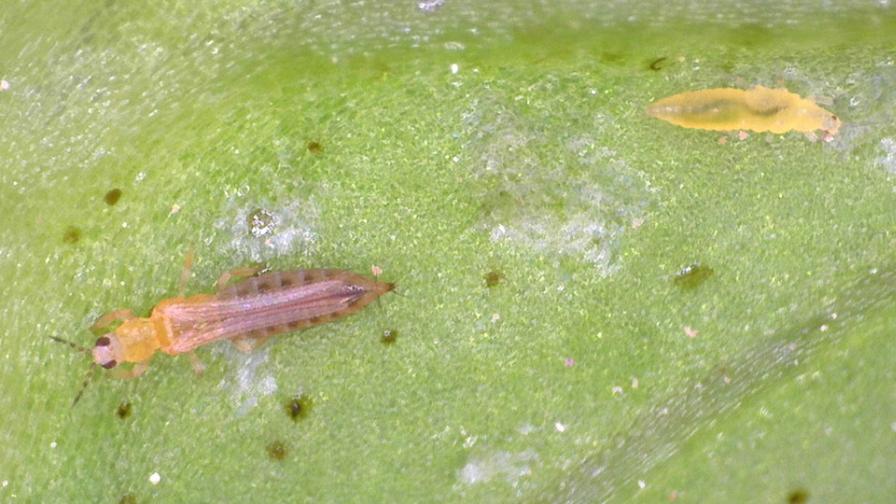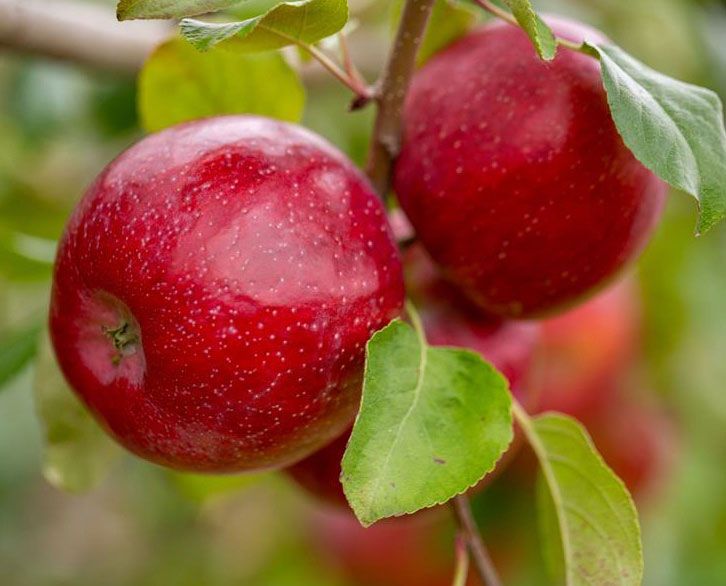How Vegetable Growers Can Win the Battle Against Thrips

Western flower thrips adult (left) and larva (right) feeding on lettuce. These pests are a pain for many produce growers.
Photo by John Palumbo
Thrips, including Western flower thrips (WFT), are a part of the Thysanoptera order and can be found wherever commercial crops are grown throughout the U.S.
They impact onions, tomatoes, peppers, eggplant, cucumbers, melons, watermelons, peas, lettuce, spinach, and cabbage.
Thrips’ Impact
WFT, a major pest in winter leafy vegetable crops grown in Arizona and Southern California, has the potential to cause cosmetic damage to all lettuce cultivars throughout the growing season, and particularly at harvest if not managed properly.
Both adults and larvae cause economic feeding damage in lettuce and spinach. High populations of WFT can result in significant blemishes on marketable leaf portions of lettuce, and baby spinach crops are susceptible to thrips damage on the young, terminal growth, because as leaves expand and elongate, they become scarred and distorted. And if cosmetic feeding damage is excessive, the entire crop can be rejected. Also, the presence of live thrips can contaminate the harvested product.
WFT is also a vector of impatiens necrotic spot virus (INSV) in lettuce, which has recently caused significant economic losses to lettuce crops in the Salinas Valley. To date, INSV has had minimal impact on lettuce in the Desert Southwest.
How to Treat for Thrips
Cultural management has only a limited impact on WFT populations, but sanitizing weeds in the surrounding landscape may eliminate alternate INSV hosts.
Direct observation of whole plants is the most accurate method of sampling for WFT. This involves careful examination of plant parts for the presence of WFT and feeding scars. Take care to examine folds in leaf tissue near the base of the leaves for immatures.
Crop Protection Considerations: Traditional Chemistries
| Product | Active ingredient | Mode of Action |
| Agri-Mek (Syngenta) | Abamectin | IRAC Group 6 |
| Entrust (Dow AgroSciences) | Spinosad | IRAC Group 5; nicotinic acetylcholine receptor (nAChR) allosteric activators |
| Exirel (FMC Corp.) | Cyantraniliprole | IRAC Group 28 |
| Lannate (Corteva) | Methomyl | IRAC Group 1A; Acetlycholinesterase (AChE) inhibitor |
| Movento (Bayer CropScience) | Spirotetramat | IRAC Group 23 |
| Radiant SC (Dow AgroSciences) | Spinetoram (Spinosyn) | IRAC Group 5; nicotinic acetylcholine receptor (nAChR) allosteric activators |
| Venom (Valent U.S.A.) | Dinotefuran | IRAC Group 4A |
| Torac (Nichin0) | Tolfenpyrad | IRAC Group 21A |
Controlling WFT with insecticides (e.g., spinetoram, methomyl, acephate, and tolfenpyrad) is often the only practical management alternative to prevent feeding damage in leafy vegetables.
In organic production, spinosad (Entrust) is effective against WFT in leafy vegetables. Alternatives such as azadirachtin/neem, insecticidal soaps, and pyrethrins provide suppression when used in rotation with spinosad.










